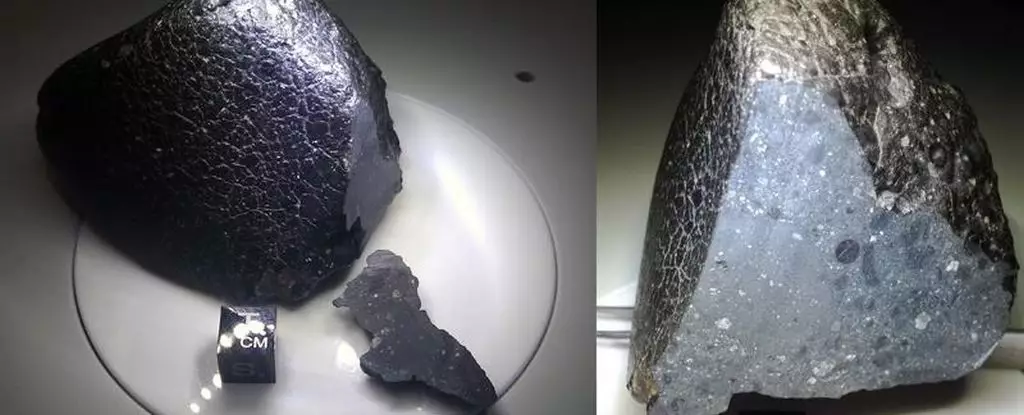Mars, the enigmatic red planet that has captured human imagination for centuries, is slowly revealing its secrets, particularly regarding its ancient environment. Recent discoveries suggest that water existed on Mars as early as 4.45 billion years ago, shortly after the planet formed from the debris surrounding the young Sun. The evidence comes from a minuscule zircon grain found within a Martian meteorite, revealing a fascinating narrative about the planet’s initial conditions. This article delves into the implications of this finding, explores the research behind it, and discusses how Earth and Mars may share a parallel history.
Geologists have long cherished zircon minerals due to their remarkable survival capabilities and potential to provide insight into planetary histories. The tiny zircon grain discovered within the Martian meteorite known as NWA 7034, or “Black Beauty,” is no exception. These ancient zircon crystals preserve vital records of the conditions prevailing on Mars when they formed. Encased within the zircon are minerals that can only exist in the presence of water, pointing to a heated aquatic environment potentially akin to that found in hot springs or hydrothermal vents.
This early water not only reshapes our understanding of Mars but also highlights the eerie similarities between the histories of Mars and Earth. As highlighted by Aaron Cavosie, a geologist from Curtin University, this discovery provides evidence that the processes leading to the acquisition of water on both planets were likely comparable. If Earth was home to liquid water at least 4.3 billion years ago, then Mars, too, must have enjoyed a similarly watery existence.
One of the most compelling aspects of the discovery of ancient water on Mars is its implications for life. The existence of hot water correlates with the thriving extremophile microbial life forms observed in hydrothermal environments on Earth. These microorganisms flourish in extreme conditions, leading researchers to contemplate the possibility that similar life forms may have once existed on Mars.
Cavosie’s assertion that both planets experienced similar early conditions raises intriguing questions. If Mars possessed environments conducive to life during the Noachian period—spanning from about 4.1 to 3.7 billion years ago—what might have evolved in those warm and wet niches? The analogy between Mars and Earth serves as a poignant reminder that life’s emergence might not be restricted to our planet but could extend to others under the right environmental conditions.
To fully appreciate Mars’ water history, it is crucial to understand the significance of the NWA 7034 meteorite. After its discovery in the Sahara Desert in 2011, it represented a rare opportunity to study Martian geology. NWA 7034 is a volcanic breccia, a rock type consisting of fragments that can reveal the geological activity of the planet.
By closely examining the minerals trapped within the zircon crystals, researchers identified elements such as iron, aluminum, and sodium. These elements, forming layered structures reminiscent of an onion, shed light on the geological processes at play during the formation of the zircon. The analogy to Earth’s Olympic Dam, where similar zircons were produced in magmatic-hydrothermal systems, suggests that Mars may have experienced similar geological dynamics during its early history.
While the discovery of hot water is groundbreaking, many questions remain unanswered. The precise temperature of this ancient Martian water is still speculative; it could have ranged anywhere from a few hundred degrees Celsius to over 500°C, mirroring the geothermal activity observed in places like Yellowstone National Park.
Equally mysterious is the volume of water present on Mars and whether any of it made it to the planet’s surface. It’s plausible that some of the magmatic fluids escaped into the atmosphere, contributing to an ancient, potentially habitable environment. The prospect of warm and wet conditions within the Martian crust expands the frontier of our understanding of Mars’ climate and habitability.
The discoveries stemming from the examination of zircon in NWA 7034 are just the beginning. As researchers probe deeper into the properties and history of these minerals, they will paint a clearer picture of the wet early Martian environment. Understanding the interplay between volcanic activity and hydrothermal systems will help scientists refine the models of early Martian climate dynamics.
As we continue to explore Mars with rovers and orbiters, each new finding can potentially reshape our understanding of planetary formation and evolution. The tantalizing possibility that Mars once hosted conditions favorable for life calls for dedicated exploration missions, enabling us to search for signs of past microbial inhabitants that may have thrived in its ancient waters.
The discovery of zircon crystals revealing ancient hot water on Mars opens up exciting avenues of research. It invites us to reconsider the origins of life and offers hope that the mysteries of our neighboring planet may one day be unraveled. As our technological capabilities advance, we remain on the precipice of uncovering the secrets that Mars holds within its barren landscapes.


Leave a Reply